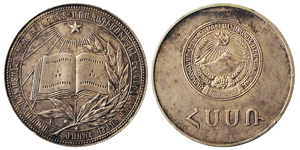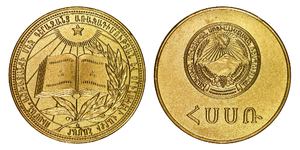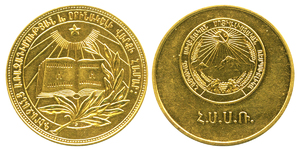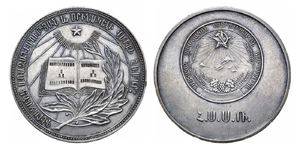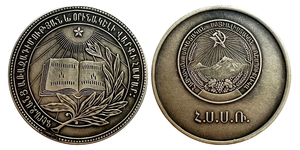Soviet School Medals
Description
The history of Soviet Armenian school medals provides a unique lens through which to view the educational and cultural shifts within the Armenian Soviet Socialist Republic. These medals, emblematic of academic excellence and behavioral exemplarity, underwent various transformations across different eras, each iteration reflecting broader changes in Soviet educational policy intertwined with Armenia’s cultural identity.
Introduced on May 30, 1945, by the Council of People's Commissars of the USSR, the concept of awarding school medals was a formal recognition of student achievement across the Soviet Union. The initial Armenian medals were crafted in gold and silver, boasting purities of 583 and 925 respectively, and featured a standard diameter of 32 mm. These medals bore the inscription in Armenian, translating to "For Exceptional Achievement and Exemplary Conduct," directly linking educational success with moral behavior in a manner that resonated deeply within the Armenian community.
In 1954, a significant modification was made to the medals. The purity of gold was reduced to 375, reflecting perhaps economic adjustments within the Soviet Union. The design adjustments were minor but notable—the star at the top of the medals was rendered more prominent, enhancing its visual appeal, though the silver medals remained unchanged in material composition.
By 1960, another redesign was unveiled as the diameter of the medals was increased to 40 mm. This change was accompanied by a shift in the materials used—tombac replaced the previous gold standard, and melchior was used for silver medals. The inscriptions were also updated to "For Outstanding Achievements and Exemplary Behavior in Education," emphasizing a broader scope of achievement within educational pursuits.
1985 marked the last significant change in the design and issuing of these medals. Silver medals were reintroduced with slight modifications, and no gold medals were issued. The inscriptions continued to evolve, with the latest reading, "For Distinguished Achievements and Exemplary Behavior in Education," signaling a continued emphasis on both academic and behavioral excellence.
The reverse side of the school medals issued in 1960 and 1985 exhibits clear differences in design. The 1960 medals featured a more detailed depiction of wheat on the coat of arms, suggesting a finer craftsmanship in their production. Additionally, the label at the bottom of the coat of arms included decorative marks, imitating the appearance of text. By contrast, the 1985 medals displayed a less detailed rendering of the wheat, indicative of a simpler design approach. Furthermore, the label on the 1985 version was left completely blank, with no text or decorative markings at all. These changes highlight a shift in the manufacturing process and design complexity over the years.
Introduced on May 30, 1945, by the Council of People's Commissars of the USSR, the concept of awarding school medals was a formal recognition of student achievement across the Soviet Union. The initial Armenian medals were crafted in gold and silver, boasting purities of 583 and 925 respectively, and featured a standard diameter of 32 mm. These medals bore the inscription in Armenian, translating to "For Exceptional Achievement and Exemplary Conduct," directly linking educational success with moral behavior in a manner that resonated deeply within the Armenian community.
In 1954, a significant modification was made to the medals. The purity of gold was reduced to 375, reflecting perhaps economic adjustments within the Soviet Union. The design adjustments were minor but notable—the star at the top of the medals was rendered more prominent, enhancing its visual appeal, though the silver medals remained unchanged in material composition.
By 1960, another redesign was unveiled as the diameter of the medals was increased to 40 mm. This change was accompanied by a shift in the materials used—tombac replaced the previous gold standard, and melchior was used for silver medals. The inscriptions were also updated to "For Outstanding Achievements and Exemplary Behavior in Education," emphasizing a broader scope of achievement within educational pursuits.
1985 marked the last significant change in the design and issuing of these medals. Silver medals were reintroduced with slight modifications, and no gold medals were issued. The inscriptions continued to evolve, with the latest reading, "For Distinguished Achievements and Exemplary Behavior in Education," signaling a continued emphasis on both academic and behavioral excellence.
The reverse side of the school medals issued in 1960 and 1985 exhibits clear differences in design. The 1960 medals featured a more detailed depiction of wheat on the coat of arms, suggesting a finer craftsmanship in their production. Additionally, the label at the bottom of the coat of arms included decorative marks, imitating the appearance of text. By contrast, the 1985 medals displayed a less detailed rendering of the wheat, indicative of a simpler design approach. Furthermore, the label on the 1985 version was left completely blank, with no text or decorative markings at all. These changes highlight a shift in the manufacturing process and design complexity over the years.


